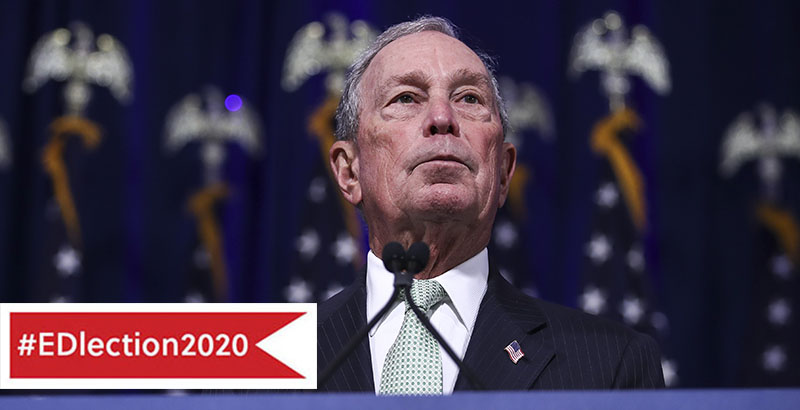Adams: Michael Bloomberg Made Sweeping Changes in NYC Schools as Mayor. What Might He Do as President?

Michael Bloomberg served as mayor of New York City from 2002 to 2013. In November 2019, he announced that he was running for president of the United States.
Less than a month later, the Programme for International Student Assessment (PISA) released the results of its 2018 exams. PISA “measures 15-year-olds’ ability to use their reading, mathematics and science knowledge and skills to meet real-life challenges,” according to the exam’s website.
America’s 15-year-olds did … about average for the developed world. Slightly above average in reading, slightly below average in math.
This was in line with scores reported in October by the National Assessment of Educational Progress (NAEP), colloquially known as the Nation’s Report Card, the “largest nationally representative and continuing assessment of what America’s students know and can do in various subject areas,” as the NAEP website says.
If elected, President Bloomberg would inherit these scores — and responsibility for raising them.
As mayor, Bloomberg attempted some sweeping reforms of NYC’s troubled educational system, which included an unprecedented level of mayoral control (something his successor, Bill de Blasio, is taking advantage of even as he dismantles many of the programs this control first brought). A look at what some of those reforms were — and their results:
Standardizing gifted and talented elementary school admissions
Previously, every NYC elementary school chose its own students for G&T programs, leading to situations in which a child could be classified as “gifted” in one area of the city but not another. Bloomberg and Chancellor Joel Klein standardized admissions, so all students would take the same test and need to reach the same qualifying score. Placement was then determined via a city Department of Education lottery. As a result, G&T programs in underserved areas where not enough students made the new cut were shuttered, and previously racially and socioeconomically diverse G&T classes became wealthier and whiter.
Opening charter schools
A passionate believer that, as in business, school competition would increase quality and ultimately benefit the consumers, Bloomberg permitted nearly 200 charter schools to open during his tenure. While, as with traditional public schools, quality varies widely, in 2018, of the top 25 elementary schools in the city, as measured by test scores, 16 were charter schools. Every one has helped to reduce the achievement gap for minority and economically disadvantaged students.
Adding specialized high schools
Bloomberg’s successor is attempting to make the city’s specialized high schools more racially and socioeconomically balanced by limiting who can apply and how students are selected. Bloomberg, when faced with much more demand for seats than Stuyvesant, Brooklyn Tech and Bronx High School of Science could accommodate, created five more specialized high schools. All eight remain majority Asian, with 190 black students (4 percent of all students) and 316 Latino students (6.6 percent) offered seats this year.
Opening high school admissions citywide and creating more screened high schools
Previously, outside the three original specialized schools, most students were limited to attending high schools in their district. Bloomberg opened up admissions citywide (though wealthy District 2, which includes Tribeca, Chelsea, Murray Hill and the Upper East Side, was allowed to keep a district priority — meaning that even though, on paper, teens from all across the city could apply to its high-performing schools, 99 percent of students are local). He also created dozens of smaller high schools, including highly selective screened schools such as Bard High School Early College, Columbia Secondary and iSchool, which use grades and test scores for admission.
Closing failing schools
If a school wasn’t delivering results, Bloomberg closed it. Or, to put it more gently, it was phased out. A 2015 report found that students who were sent to different schools were more likely to graduate.
Higher teacher pay, merit pay, evaluations & rubber rooms
Bloomberg first raised pay for all public school teachers, then proposed merit pay and piloted a program at a few hundred low-performing schools. These bonuses were later deemed ineffective at raising student achievement. The city began rating elementary and middle school teachers based on how well their students did on standardized tests. A deal was reached to get rid of so-called rubber rooms, where teachers accused of incompetence or wrongdoing were paid to sit and do nothing. The city still maintains an absent teacher reserve pool, where tenured teachers and guidance counselors from closed-down schools, as well as some removed for misconduct or incompetence, continue to draw a salary and receive benefits while rotating through support positions ranging from library to lunch duty to substitute teaching.
Social promotion ban
In 2005, Bloomberg ended social promotion, whereby students are automatically sent to the next grade whether or not they have demonstrated basic competency in their current grade’s core subjects, for seventh-graders. In 2009, he moved to eliminate it in grades 3 through 8. By 2012, the policy was back, after the department observed that “46 percent of children who were held back more than once drop out before they graduate from high school, compared to 29 percent of children who were held back once and 11 percent of those who were not held back at all,” as reported by DNAinfo.com.
If he’s elected president, will we be seeing some of these policies on the national level?
Alina Adams is a New York Times best-selling romance and mystery writer, the author of Getting Into NYC Kindergarten and Getting Into NYC High School, a blogger at New York School Talk and mother of three. She believes you can’t have true school choice until all parents know all their school choices — and how to get them. Visit her website, www.NYCSchoolSecrets.com.
Get stories like these delivered straight to your inbox. Sign up for The 74 Newsletter

;)
